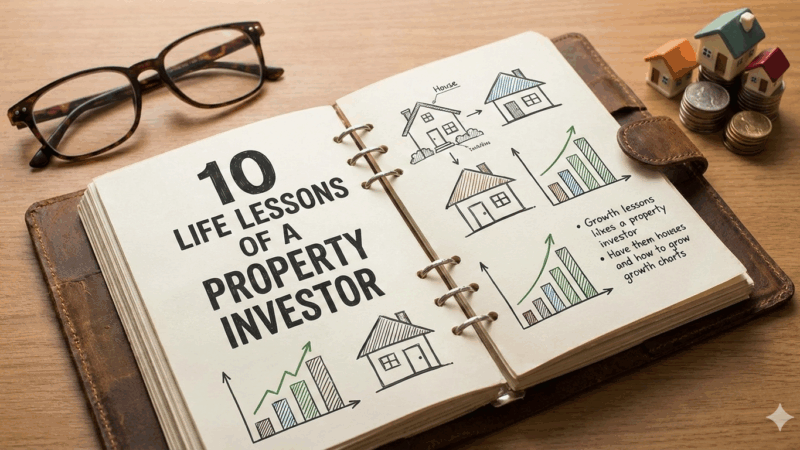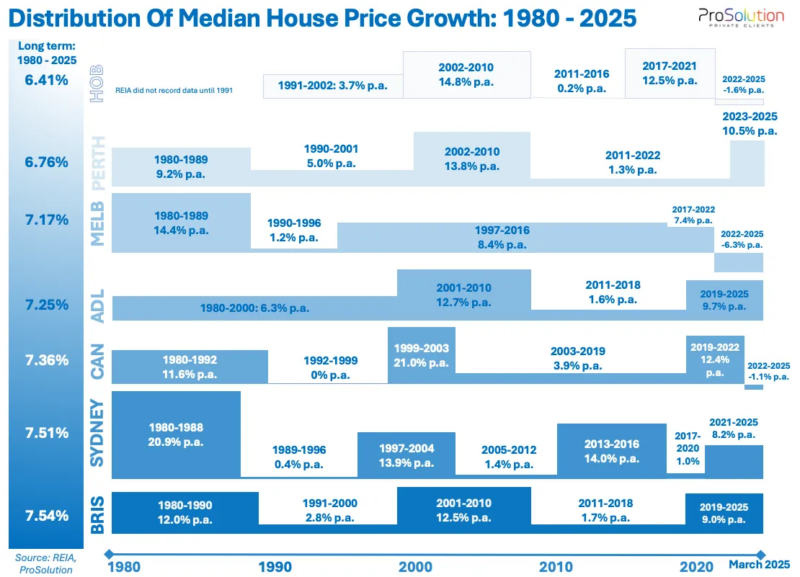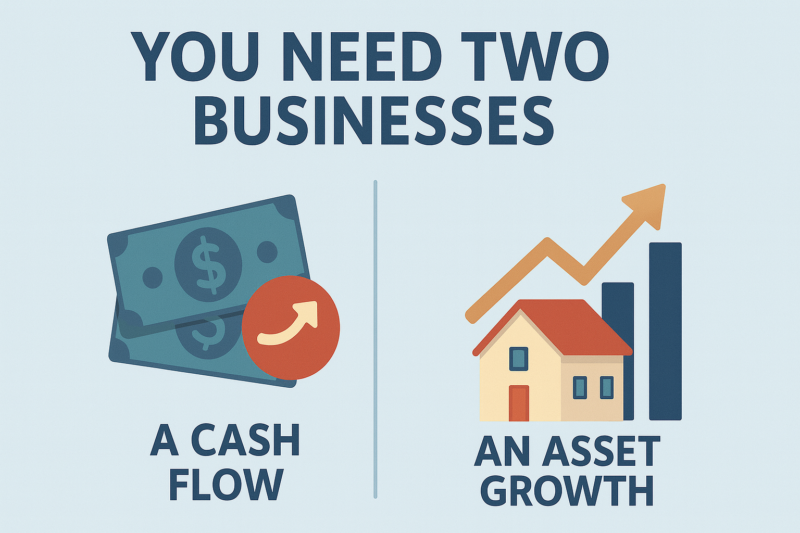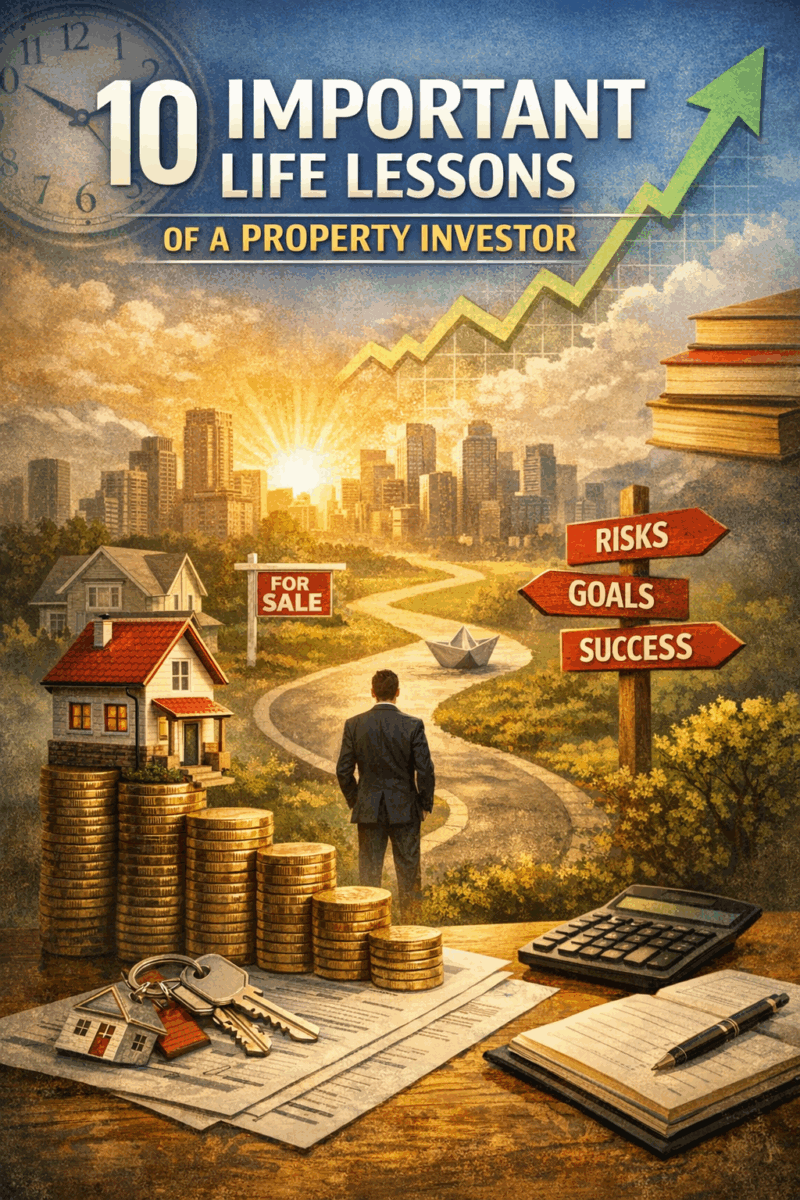
Key takeaways
Great investing starts with a clear plan and strategic system, not guesswork.
Long-term thinking beats short-term noise every time.
Treat your property investing as a real business with teams and structures around you.
There’s no single “property market”; know the submarkets that matter.
Follow the crowd at your peril – sentiment swings drive cycles.
There will always be reasons not to invest – it’s part of the journey.
Details matter, but keep your eye on the big picture.
Investment success is about solid property fundamentals, not fads.
Use debt strategically as a tool, not something to fear.
Long-term property values are driven by population growth and national wealth.
Most people think property investing is all about buying the right property at the right time.
In reality, that’s only part of the story.
The real lessons show up over decades, through cycles, setbacks, mistakes, and the quiet compounding that only time can deliver.
After more than 50 years of investing, advising, and watching thousands of Australians build wealth through property, I’ve learned that success has far less to do with luck than most people think.
It comes down to mindset, strategy, patience, and understanding how the property markets actually work, not how the media portrays them.
These are the life lessons property investing teaches you if you stick around long enough.
They’re not glamorous, they won’t make headlines, but they’re the principles that separate those who quietly build substantial wealth from those who keep starting over.
1. Have a plan
Strategic investors have a plan; they know where they are heading and follow a proven system to take the emotion out of their decisions and give them more consistent results.
They make informed investment decisions based on research, buy a property below its intrinsic value in an area with above-average long-term capital growth, and add value to create equity.
They recognise that attaining wealth doesn’t just happen; it’s the result of a well-executed plan, and that planning is bringing their future into the present so they can do something about it now!
They make informed investment decisions based on research, buy a property below its intrinsic value in an area with above-average long-term capital growth, and add value to create equity.
You see... property investment is a process, not an event, and the property you eventually buy will be the physical manifestation of many decisions made in the right order.
These decisions are all part of this strategic plan - that's why at Metropole, long before we even started talking about property, we help our clients by putting together a personalised plan.
By having a Strategic Property Plan, you’re more likely to achieve the financial freedom you desire because we’ll help you:
- Define your financial goals;
- See whether your goals are realistic, especially for your timeline;
- Measure your progress towards your goals – whether your property portfolio is working for you, or if you’re working for it.
- Find ways to maximise your wealth creation through property;
- Identify risks you hadn’t thought of.
And the real benefit is you’ll be able to grow your wealth through your property portfolio faster and more safely than the average investor.
Your Strategic Property Plan should contain the following components:
- An asset accumulation strategy
- A manufacturing capital growth strategy
- A rental growth strategy
- An asset protection and tax minimisation strategy
- A finance strategy including long-term debt reduction and…
- A living off your property portfolio strategy
2. Take a long-term perspective
The property market moves in cycles, and in every decade, there are a number of years of flat or falling property prices; however, well-located real estate has increased in value by an average of over 7 per cent per annum over the long term.

Imagine if you could buy the house your parents bought at the price they paid thirty or forty years ago; how many properties would you have bought then, knowing what those properties would be worth today?
Research by Stuart Wemyss, financial advisor from ProSolution Private Clients is summarised in the chart below showing long-term property price growth over the last 45 years and national median house value has risen by an enormous 540.1% over the past 45 years.
This is an average annual growth rate of 7.62%. Of course, these numbers vary by state.
Now these are just overall averages. Within each state, some locations have experienced significantly more capital growth than the average, while others have underperformed. That's how averages work.
At Metropole, we dedicate considerable time to researching locations that deliver wealth-producing rates of capital growth.
3. Treat your property investment like a business
The successful investors I know have grown a substantial asset base by treating their investments like a business.
They achieve this by surrounding themselves with a great team of advisors, securing the right type of finance, establishing the correct ownership and asset protection structures, and leveraging the taxation system to their advantage.
They actually have two businesses:
- A cash flow business, which is their job, profession, or real business, that gives them the cash flow to live on and to service their second business, which is...
- A capital growth business (their property business), which they allow to grow over the long term until it is big enough to generate sufficient cash flow that they can leave their first business.
4. There is not one property market
While many people generalise about “the property market”, there are many submarkets around Australia.
Each state is at a different stage of its property cycle and within each state, geography, price points, and type of property segment the markets.
For example, the top end of the market will perform differently from the new homebuyers market or the investor segment, or the median-priced established property sector.
And while at any time there are hundreds of thousands of properties for sale in Australia, most are not investment-grade properties.
5. The crowd is usually wrong
“Crowd psychology” influences people’s investment decisions, often to their detriment.
Investors tend to be most optimistic near the peak of the cycle, at a time when they should be the most cautious and they’re the most pessimistic when all the doom and gloom is in the media near the bottom of the cycle when there is the least downside (as is happening now.)
Market sentiment is a key driver of property cycles and one of the reasons why our markets overreact, overshooting the mark during booms and getting too depressed during slumps.
Remember that each property boom sets us up for the next downturn, just as each downturn sets the scene for the next upswing.
That's why I currently see a window of opportunity in the Melbourne property market for property investors with a long-term focus which is now reviving after a number of flat years.
In fact, there is currently a window of opportunity for property investors in many parts of Australia, as we are working our way through a property super cycle.
Note: A supercycle in property markets refers to an extended period of sustained price growth, driven by a combination of economic and demographic factors.
There are, several key indicators suggest we’re heading into a period of prolonged property price growth:
- Stock Shortages – There just aren’t enough properties on the market to meet demand. This is a structural issue, not a short-term trend.
- Population Growth – Australia’s post-pandemic migration boom is adding hundreds of thousands of new residents each year, increasing the need for housing.
- Interest Rate Stability – While rates remain higher than a few years ago, we’ve now moved past the cycle of constant rate hikes. A stable rate environment helps improve buyer confidence.
- Rental Crisis – With vacancy rates at record lows and rents skyrocketing, more investors are entering the market, further fuelling demand.
- Construction Bottlenecks – The high cost of building and supply chain delays mean that new housing supply isn’t keeping up with demand.
All of these factors combined create the perfect storm for continued price growth.
Strategic investors will take advantage of the opportunities our property markets will offer over the next couple of years, maximising their upsides while protecting their downsides.
6. There will always be reasons not to invest
Every year brings its own set of crises and lots of reasons not to invest.
You can go back as far in history as you like, and there won’t be a crisis-free year.
Sure, some years are worse than others, but there is always bad news, and much of it is unexpected.
Where investors get into trouble is that rather than focusing on their long-term goals, they see these crises as once-in-a-generation events that will alter the course of history, when in reality they are just the normal path of history.
And currently, there are many stories in the media telling us why our property markets are overpriced and property values can't keep rising, while other property pessimists will tell us that property prices are now going to crash - in general, these are by the same people who made the same forecast a couple of years ago.
Sure, our markets are facing headwinds and of course, there are uncertainties regarding what's going to happen to interest rates, but contrary to the property pessimists, they won't crash.
7. The devil is in the detail
With so much market analysis available to us today, it’s easy to get caught up in the detail and scared into inaction.
It’s better to keep an eye on the big picture and look at the property markets through a telescope and not a microscope.
But remember property investing part ‘art’ and part ‘science’?
It’s true that successful property investors need research and data to aid an investment decision, but it’s not enough on its own. Investors must also complement applicable data with local area knowledge, expertise, experience, and perspective to make the best-informed choices.
Someone looking at data can make it say almost anything they want; the trick is knowing how to take that information and use it with some practical experience to make an investment decision accurately.
That's why, in my opinion, experienced buyer’s agents are so valuable as part of your team – they bring the “art” part of the investment equation to property investors who have done internet and data research to cover the “science” part of the investment.
8. Remember it’s about property
You’re in the business of property investment, yet at times investors forget the age-old rule of buying the best property they could afford in proven locations.
Instead, they get sidetracked by get-rich-quick schemes or glamorous finance or tax strategies and lose out.
The fact is…property is not a get-rich-quick scheme.
Don’t get carried away by the next hot spot or latest fad – make your investing boring, so that the rest of your life can be exciting.
Warren Buffet was right when he said; “Wealth is the transfer of money from the impatient to the patient.”
9. Use debt as a tool
While many people worry about debt, smart investors use “good debt” and leverage to build their asset base.
They then protect their assets by buying time by having a “rainy day” cashflow buffer set aside in a line of credit or offset account.
10. The 2 big drivers of property values
While in the short term our property markets will be driven by market sentiment, interest rates, supply and demand, and micro-economic factors; in the long term, the value of well-located properties will rise propelled by the twin factors that have always driven long-term property prices – Demographics (population growth) and the wealth of the nation.
Both of which will increase substantially over the next few decades.
I've written a detailed article about what really causes property price growth here.
What about you...
Learn from these lessons, and the rollercoaster ride of your property investment career may not be as dramatic.
Remember, both fear and greed will send you down the wrong path, but sense and sensibility will keep you heading in the right direction, toward real estate riches.
While there will be ups and downs and many challenges ahead, we are indeed a fortunate country, and our economy will remain the envy of the developed world.
So, if like me, you are confident that Australia has a prosperous future and at the same time our population is going to grow, this means we’ll have more people who will need property for shelter and their prosperous lifestyles will allow them to afford quality property.
This means the long-term viability of our property markets is assured.
In the short term, there will be some challenges and some great opportunities, so it is critical to learn from experienced and successful property investors, from someone who has already achieved what you want to achieve and has retained their wealth in the long term.
Owning real assets is a powerful wealth creator and with our property markets moving on, as the report suggests, a whole new generation of property millionaires will be created over the new decade.
However, if history repeats itself, and it most likely will, most people who get involved in property investment will not become financially independent.
Many will buy the wrong property at the wrong time or in the wrong location.


















